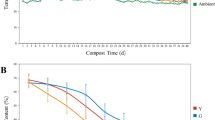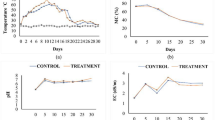Abstract
Bean curd dreg (BCD) is a by-product of bean products, which can be used as a great ingredient for composting, but it combined with cow manure and corn stalk composting was rarely reported. In this study, the effect of BCD on the maturity and the micro-ecological environment was investigated under a lab-scale composting experiment and found that BCD was conducive to improve the maturity of compost during the BCD application. The excitation-emission matrix (EEM) showed that the final humus content in BCD treatments was richer than that in CK treatment. High-throughput sequencing results showed that BCD-applied better ameliorated the bacteria community structure with higher Actinomycetes abundance and lower denitrifying bacteria abundance in the late stage of composting. PICRUSt results showed that BCD-added decreased the abundance of microbial metabolic genes in the high temperature period (> 70 °C), but the metabolic abundance increased rapidly as the temperature cooled down. Compared with CK, the metabolic abundance decreased significantly on day 24, which was consistent with the conclusion of composting maturity. Redundancy analysis (RDA) results indicated that there were significant discrepancies in the microbial community structure of samples at different composting periods and the change of the dominant population in the BCD-treated compost samples were more outstanding than that in the CK treatment. Hence, BCD is a very good composting modifier that compensates for the disadvantages of composting and enhances the fertility of the compost product.







Similar content being viewed by others
References
Awasthi MK, Awasthi SK, Wang Q, Awasthi MK, Zhao J, Chen H, Ren X, Wang M, Zhang Z (2018) Role of Ca-bentonite to improve the humification, enzymatic activities, nutrient transformation and end product quality during sewage sludge composting. Bioresour Technol 262:80–89
Awasthi MK, Zhang Z, Wang Q, Shen F, Li R, Li D, Ren X, Wang M, Chen H, Zhao J (2017) New insight with the effects of biochar amendment on bacterial diversity as indicators of biomarkers support the thermophilic phase during sewage sludge composting. Bioresour Technol 238:589–601
Campitelli P, Ceppi S (2008) Chemical, physical and biological compost and vermicompost characterization: a chemometric study. Chemom Intell Lab Syst 90:64–71
Chen W, Westerhoff P, Leenheer JA, Booksh K (2003) Fluorescence excitation−emission matrix regional integration to quantify spectra for dissolved organic matter. Environ Sci Technol 37:5701–5710
Diaz MJ, Eugenio ME, Jiménez L, Madejón E, Cabrera F (2003) Modelling vinasse/cotton waste ratio incubation for optimum composting. Chem Eng J (Lausanne, Switzerland: 1996),93:233-240.
Duan M, Zhang Y, Zhou B, Qin Z, Wu J, Wang Q, Yin Y (2020) Effects of Bacillus subtilis on carbon components and microbial functional metabolism during cow manure–straw composting. Bioresour Technol 303:122868
Finkmann W, Altendorf K, Stackebrandt E, Lipski A (2000) Characterization of N2O-producing Xanthomonas-like isolates from biofilters as Stenotrophomonas nitritireducens sp. nov., Luteimonas mephitis gen. nov., sp. nov. and Pseudoxanthomonas broegbernensis gen. nov., sp. nov. International journal of systematic and evolutionary microbiology,50 Pt 1:273-282.
Helfrich P, Chefetz B, Hadar Y, Chen Y, Schnabl H (1998) A novel method for determining phytotoxicity in composts. Comp Sci Util 6:6–13
Jiang J, Kang K, Chen D, Liu N (2018) Impacts of delayed addition of N-rich and acidic substrates on nitrogen loss and compost quality during pig manure composting. Waste Manag 72:161–167
Langille MGI, Zaneveld J, Caporaso JG, Mcdonald D, Knights D, Reyes JA, Clemente JC, Burkepile DE, Vega Thurber RL, Knight R, Beiko RG, Huttenhower C (2013) Predictive functional profiling of microbial communities using 16S rRNA marker gene sequences. Nat Biotechnol 31:814–821
Lebuhn M, Hanreich A, Klocke M, Schlüter A, Bauer C, Pérez CM (2014) Towards molecular biomarkers for biogas production from lignocellulose-rich substrates. Anaerobe 29:10–21
Leclerc A, Laurent A (2017) Framework for estimating toxic releases from the application of manure on agricultural soil: national release inventories for heavy metals in 2000-2014. Sci Total Environ,590-591:452-460.
Liu N, Hou T, Yin H, Han L, Huang G (2019) Effects of amoxicillin on nitrogen transformation and bacterial community succession during aerobic composting. J Hazard Mater 362:258–265
Lv B, Xing M, Yang J, Qi W, Lu Y (2013) Chemical and spectroscopic characterization of water extractable organic matter during vermicomposting of cattle dung. Bioresour Technol 132:320–326
Maeda K, Miyatake F, Asano R, Nakajima K, Maeda T, Iwabuchi K (2018) Response of the denitrifier community and its relationship with multiple N2O emission peaks after mature compost addition into dairy manure compost with forced aeration. Chemosphere 206:310–319
Man Ting Chan ASJW (2016) Reducing nitrogen loss and salinity during ‘struvite’ food waste composting by zeolite amendment. Bioresour Technol 200:838–844
Mao H, Wang K, Wang Z, Peng J, Ren N (2020) Metabolic function, trophic mode, organics degradation ability and influence factor of bacterial and fungal communities in chicken manure composting. Bioresour Technol 302:122883
Meng Q, Yang W, Men M, Bello A, Xu X, Xu B, Deng L, Jiang X, Sheng S, Wu X, Han Y, Zhu H (2019) Microbial community succession and response to environmental variables during cow manure and corn straw composting. Front Microbiol 10:529
Nada WM (2015) Stability and maturity of maize stalks compost as affected by aeration rate, C/N ratio and moisture content. J Soil Sci Plant Nutr 15:751–764
Partanen P, Hultman J, Paulin L, Auvinen P, Romantschuk M (2010) Bacterial diversity at different stages of the composting process. BMC Microbiol 10:94
Qiao C, Ryan Penton C, Liu C, Shen Z, Ou Y, Liu Z, Xu X, Li R, Shen Q (2019) Key extracellular enzymes triggered high-efficiency composting associated with bacterial community succession. Bioresour Technol 288:121576
Rashad FM, Saleh WD, Moselhy MA (2010) Bioconversion of rice straw and certain agro-industrial wastes to amendments for organic farming systems: 1. Composting, quality, stability and maturity indices. Bioresour Technol 101:5952–5960
Rastogi G, Bhalla A, Adhikari A, Bischoff KM, Hughes SR, Christopher LP, Sani RK (2010) Characterization of thermostable cellulases produced by Bacillus and Geobacillus strains. Bioresour Technol 101:8798–8806
Ruan C, Ai K, Lu L (2014) Biomass-derived carbon materials for high-performance supercapacitor electrodes. RSC Adv 4:30887
Shao Z, He P, Zhang D, Shao L (2009) Characterization of water-extractable organic matter during the biostabilization of municipal solid waste. J Hazard Mater 164:1191–1197
Steger K, Jarvis Å, Vasara T, Romantschuk M, Sundh I (2007) Effects of differing temperature management on development of Actinobacteria populations during composting. Res Microbiol 158:617–624
Talia P, Sede SM, Campos E, Rorig M, Principi D, Tosto D, Hopp HE, Grasso D, Cataldi A (2012) Biodiversity characterization of cellulolytic bacteria present on native Chaco soil by comparison of ribosomal RNA genes. Res Microbiol 163:221–232
Teng Y, Liu K, Liu R, Yang Z, Wang L, Jiang H, Ding R, Liu E (2017) A novel copper nanoparticles/bean dregs-based activated carbon composite as pseudocapacitors. Mater Res Bull 89:33–41
Thelusmond J, Strathmann TJ, Cupples AM (2016) The identification of carbamazepine biodegrading phylotypes and phylotypes sensitive to carbamazepine exposure in two soil microbial communities. Sci Total Environ 571:1241–1252
Wang K, Li W, Gong X, Li Y, Wu C, Ren N (2013) Spectral study of dissolved organic matter in biosolid during the composting process using inorganic bulking agent: UV–vis, GPC, FTIR and EEM. Int Biodeterior Biodegradation 85:617–623
Wang C, Guo X, Deng H, Dong D, Tu Q, Wu W (2014) New insights into the structure and dynamics of actinomycetal community during manure composting. Appl Microbiol Biotechnol 98:3327–3337
Wang Q, Wang Z, Awasthi MK, Jiang Y, Li R, Ren X, Zhao J, Shen F, Wang M, Zhang Z (2016) Evaluation of medical stone amendment for the reduction of nitrogen loss and bioavailability of heavy metals during pig manure composting. Bioresour Technol 220:297–304
Wang K, Mao H, Wang Z, Tian Y (2018a) Succession of organics metabolic function of bacterial community in swine manure composting. J Hazard Mater 360:471–480
Wang X, Ye C, Zhang Z, Guo Y, Yang R, Chen S (2018b) Effects of temperature shock on N2O emissions from denitrifying activated sludge and associated active bacteria. Bioresour Technol 249:605–611
Wang Y, Liu L, Yang J, Duan Y, Luo Y, Taherzadeh MJ, Li Y, Li H, Awasthi MK, Zhao Z (2020) The diversity of microbial community and function varied in response to different agricultural residues composting. Sci Total Environ 715:136983
Wei H, Wang L, Hassan M, Xie B (2018) Succession of the functional microbial communities and the metabolic functions in maize straw composting process. Bioresour Technol 256:333–341
Yamamoto N, Otawa K, Nakai Y (2010) Diversity and abundance of ammonia-oxidizing bacteria and ammonia-oxidizing archaea during cattle manure composting. Microb Ecol 60:807–815
Yang Y, Awasthi MK, Bao H, Bie J, Lei S, Lv J (2020) Exploring the microbial mechanisms of organic matter transformation during pig manure composting amended with bean dregs and biochar. Bioresour Technol 313:123647
Zeng G, Zhang J, Chen Y, Yu Z, Yu M, Li H, Liu Z, Chen M, Lu L, Hu C (2011) Relative contributions of archaea and bacteria to microbial ammonia oxidation differ under different conditions during agricultural waste composting. Bioresour Technol 102:9026–9032
Zhang L, Sun X (2018) Effects of bean dregs and crab shell powder additives on the composting of green waste. Bioresour Technol 260:283–293
Zhang L, Li L, Pan X, Shi Z, Feng X, Gong B, Li J, Wang L (2018) Enhanced growth and activities of the dominant functional microbiota of chicken manure composts in the presence of maize straw. Frontiers in Microbiology,9.
Zhang L, Li L, Sha G, Liu C, Wang Z, Wang L (2020) Aerobic composting as an effective cow manure management strategy for reducing the dissemination of antibiotic resistance genes: an integrated meta-omics study. J Hazard Mater 386:121895
Zhang S, Chen Z, Wen Q, Zheng J (2016) Assessing the stability in composting of penicillin mycelial dreg via parallel factor (PARAFAC) analysis of fluorescence excitation–emission matrix (EEM). Chem Eng J 299:167–176
Zhao Y, Lu Q, Wei Y, Cui H, Zhang X, Wang X, Shan S, Wei Z (2016) Effect of actinobacteria agent inoculation methods on cellulose degradation during composting based on redundancy analysis. Bioresour Technol 219:196–203
Zhong XZ, Li XX, Zeng Y, Wang SP, Sun ZY, Tang YQ (2020) Dynamic change of bacterial community during dairy manure composting process revealed by high-throughput sequencing and advanced bioinformatics tools. Bioresour Technol 306:123091
Zhu G, Zhu X, Xiao Z, Zhou R, Yi F (2012) Pyrolysis characteristics of bean dregs and in situ visualization of pyrolysis transformation. Waste Manag 32:2287–2293
Acknowledgements
The authors gratefully acknowledge their family, teachers, and classmates for their help in making this study more meaningful.
Data and materials availability
The datasets used or analyzed during the current study are available from the corresponding author on reasonable request.
Funding
This work was financially supported by Jilin Provincial Department of Education “13th five-year” science and technology project (JJKH20190714KJ), Science and Technology Development Project of Jilin Province (20180101309JC).
Author information
Authors and Affiliations
Contributions
Bing Wang: writing-reviewing and editing.
Jianquan Yan: writing-original draft preparation and editing, software.
Guomin Li: data curation, software.
Qingtong Cao: conceptualization, methodology, validation.
Houhe Chen: visualization.
Jian Zhang: supervision.
Corresponding author
Ethics declarations
Competing interests
The authors declare no competing interests.
Ethics approval and consent to participate
Not applicable.
Consent for publication
The author confirms that its publication has been approved by all co-authors.
Additional information
Responsible Editor: Diane Purchase
Publisher’s note
Springer Nature remains neutral with regard to jurisdictional claims in published maps and institutional affiliations.
Rights and permissions
About this article
Cite this article
Wang, B., Yan, J., Li, G. et al. The addition of bean curd dreg improved the quality of mixed cow manure and corn stalk composting: enhancing the maturity and improving the micro-ecological environment. Environ Sci Pollut Res 28, 27095–27108 (2021). https://doi.org/10.1007/s11356-021-12572-y
Received:
Accepted:
Published:
Issue Date:
DOI: https://doi.org/10.1007/s11356-021-12572-y




